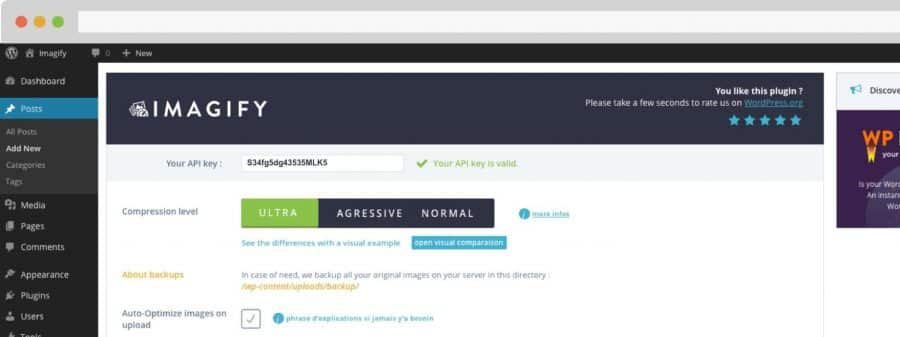Google research has found that 53% of people abandon websites that take over 3 seconds to load; quite the impossible feat considering that the average website takes 19 seconds to load on a 3G signal!
Websites that load in 5 seconds versus 19 seconds were also found to have:
- 25% higher ad viewability
- 70% longer average sessions
- 35% lower bounce rates
With file sizes and applications needing more space, web developers are challenged to create websites that not only perform well but load fast. Google counts website speed as a ranking factor, which contributes to the overall usability of the website (which, in turn, represents another Google ranking factor of high importance).
Understanding the importance of WordPress speed optimization cannot be understated. With this in mind, here’s how to enact WordPress speed optimization for your own website, using the best free and paid plugins to assist your efforts—with plenty of options to fit any budget.
But your WordPress speed optimization efforts shouldn’t begin and end with the use of plugins, which is why we’ve shared 5 additional steps to consider for success.
Ready? Let’s get started.
1. Choose a Good Web Host
It all starts with a good foundation.
Even if you do everything right with WordPress speed optimization, a slow web host will certainly get in the way of all of your optimization tricks and configured plugins.
When a person loads a new web page, files are pulled from the web servers that store them. If you have a fast server, file retrieval will likewise be quick, which is why choosing a good web host is essential.
But the characteristics of a good web host don’t begin and end with speed. A good web host must also offer good customer support to ensure that your site can quickly get back online if it crashes. If you run an ecommerce site, every second that your website is down can result in a proportionate loss of revenue.
Website backup is another important consideration when choosing a good web host to complement your WordPress speed optimization efforts. A good backup system ensures that there are extra copies of your important website files and content in case you accidentally break your WordPress installation. Yes, there are plugins that can take care of the backup process (such as Duplicator). That said, the smoothest restore process usually relates to your web host’s own internal backup system.
There are several types of web hosting and hosting provides to consider, but if you’re just starting out, shared hosting will do. In this situation, you will be sharing your web server with several other websites.
Shared hosting will keep hosting costs low but as you grow, you’ll want to consider paying extra for private servers (also known as dedicated hosting). Private servers can help you scale as your website experiences higher web traffic and requires higher security.
2. Use a WordPress Theme Optimized for Speed
Another important foundational element when it comes to WordPress theme optimization? Your website’s theme! Ignoring how huge theme-related files contribute to page load will have you scrambling to optimize everything and anything, to little positive result.
WordPress themes that have been optimized with speed in mind usually call this into attention on related promotional materials describing their benefits. It’s worth noting that WordPress’s own 2018, 2017, 2016 (and so on) themes are built for speed… but are often too simplistic in design for business purposes (not to mention the fact that so many people use them and they can appear unoriginal!).
WooVina has been built with WordPress speed optimization in mind.

Graciously, it’s easy to customize—even for a beginner—thanks to integrations with a lot of popular WordPress plugins and widgets, including page builders and ecommerce plugins. It’s also mobile-responsive: an important ranking factor in light of Google’s mobile-first initiative (and the fact that more than half of web searches are done on mobile!).
If you ever get stuck or want personalized advice on getting the most out of your OceanWP theme, customer support is available for priority users.
3. Use the Right WordPress Plugins
One of the best things about WordPress is how easy it is to customize for your needs, thanks in part to the use of available plugins: both paid and free. In this article, we’ll take you through multiple options for WordPress speed optimization. The good news? Quality is achievable at any budget (even $0!).
It should come as no surprise that paid plugins are generally believed to work better and offer advanced features when compared with free plugins of a similar nature.
While this is true most of the time, you should still arm yourself with knowledge by reading reviews and drawing comparisons with other free and paid plugin options. Just because a plugin works well for someone you know, doesn’t always mean that the same will be true for you. Every website (and it’s structure) is different!
With all this in mind, here are some of the best WordPress speed optimization plugins to complement a speedy web host and optimized WordPress theme:
Paid Caching Plugin: WP Rocket

Caching assists in faster page load by storing static files after the pages’ first load in your browser.
WP Rocket is a caching plugin with multiple features like Cloudflare compatibility, CDN, browser caching, and GZIP compression. GZIP compression makes file sizes smaller and a content delivery network (CDN), such as Cloudflare, sends your website content to the server closest to the visitor to make site load time faster. This works because the distance of the server to the website visitor makes a noticeable difference when it comes to site load time.
The WP Rocket plugin offers both features, meaning that you don’t have to purchase or configure additional plugins for these tasks. In general, the less plugins you install, the better—all related files can work against your efforts when it comes to WordPress speed optimization! If you’re a developer or agency working with a lot of clients, you can opt to use their white label option to remove references to WP Rocket.
WP Rocket prices start at $39/year for a single website and $199/year for unlimited websites.
Free Caching Plugin: WP Fastest Cache

One way to make your WordPress site load faster is through the use of a caching plugin.
Websites are made up of many different individual web pages. Every time someone visits your site, WordPress runs a process to retrieve information from the server, to displaying it, which can take a lot of time when there are a lot of visitors on your website.
Essentially, what a caching plugin does is shorten this process by making a copy of a particular page after the first load, storing the copy, then retrieving that copy the next time someone visits the website. Files that can be stored in the browser cache include: HTML files, CSS style sheets, Javascript scripts, images, and other multimedia.
One of the most popular free caching plugins on the market is WP Fastest Cache with over 500,000 installations. It offers many options and features, such as the ability to enable/disable cached options for mobile devices and logged in users, GZIP compression, leverage browser caching, cache timeout, and a multiple languages function.
Paid Image Optimization Plugin: Imagify

Images make up the bulk of the web host’s files—especially high resolution images. Simply editing or resizing a photo is often not enough to fix a page load issue and it might negatively alter the original file’s resolution.
Because of this, there’s a need for image optimization plugins such as Imagify. Using Imagify for WordPress speed optimization:
- Covers all the basic image files (JPEG, PNG, GIF)
- Allows you to resize your images on the go
- Is easy to use (not many settings)
Imagify offers plans that start at 1GB of data per month (about 10,000 images) for $4.99 (and $5 per additional GB) and can go up to as high as $69.99/month for 50GB of data ($1 per additional GB). It works with WordPress only for now, but will soon have extensions available for PrestaShop, Magento, Shopify and Joomla.
Free Image Optimization Plugin: WP Smush

If you have a particularly image-heavy website, you will need to optimize your images—they’re often the main reason for slow loading websites. Images take up 60% of the average bytes loaded per page, which makes up the bulk of all HTTP requests sent.
You can optimize images before uploading them by resizing the file or changing the file format, and you can also use image optimization plugins such as WP Smush.
WP Smush is one of the most popular image optimization plugins, with over 1 million downloads (and recently, they were a Champion in Torque’s 2017 Plugin Madness competition). WP Smush features include the ability to compress images in any directory (not just in media uploads), compatibility with other media library plugins (such as NextGen Gallery and WP All Import), multisite adaptability, and the option to auto-smush or manually smush attachments (up to 50 images at a time).
Aside from WP Smush, another top image optimization plugin is EWWW Image Optimizer, which converts your image to the best file format.
Free GZIP Compression Plugin: WP Performance Score Booster

If your files are still taking up a lot of space, even after using an image optimization plugin, it may be time to explore GZIP compression.
GZIP compression is a method of compressing HTML and CSS files to make them 50-70% smaller. This is done through web server configuration, namely through .htaccess, Apache, Nginx, and Litespeed web servers. To check if files are zipped (using a caching plugin like the aforementioned WP Fastest Cache or WP Rocket), install a plugin like WP Performance Score Booster.
4. Use a CDN

The location of your server can also affect website loading times: the nearer your server is to a given visitor, the faster the content gets delivered to that location.
If you have website visitors from all over the world (and you probably do), a content delivery network (CDN) can help you speed up page load. A CDN is made up of servers from all over the world, storing the static files that make up your website. The term “static files” refers to files that do not change, such as images, CSS, and Javascript.
Cloudflare is one of the most popular tools used for websites, offering CDNs and internet security services.
5. Keep Your WordPress Website Updated
WordPress is an open-source project, and its core code is updated frequently.
These updates are important to fix issues and bugs, as well as offer new features. Both plugins and themes may also be updated from time to time.
It’s important to keep your WordPress website regularly updated to reduce vulnerabilities caused by security breaches, as well as to keep your site from slowing down. It’s as simple as clicking “update” next to out-of-date plugins and themes—just make sure to backup your website before making these changes!
6. Ensure that Your PHP Version is Current
The most current version of PHP is PHP 7.2, which was released in November 2017.
WordPress requires that your web host supports PHP 7.2 or greater in order for version updates to function properly. WordPress previously announced that PHP 7 would be the minimum requirement to run a WordPress self-hosted site by 2017.
Besides not being able to run your WordPress site if you don’t have the latest PHP version (because your plugins and theme wouldn’t be compatible), the reason why WordPress mandates the most updated PHP version is because it’s the fastest one, yet.
Thanks to its Zend Engine 3.0, PHP 7-powered WordPress sites experience 2-3x increase in site speed, enjoy 30-50% improvements in memory consumption, and are able serve up to 3x as many requests per second.
You can check for compatibility using a PHP compatibility checker plugin.
WordPress Speed Optimization: A Winning Website with Paid Plugins
Having a quick website can contribute to better usability, SEO, and ultimately? Greater conversions. Test your WordPress speed optimization strategy before and after with free tools like Google PageSpeed Insights (an inside look as to how Google sees your website), GTMetrix, and Pingdom.
Actionable steps for having a website with proper WordPress speed optimization include choosing the right theme, the right host, configuring caching and image optimization plugins, using a CDN, keeping your WordPress site updated on a regular basis, and making sure your PHP version is current.

